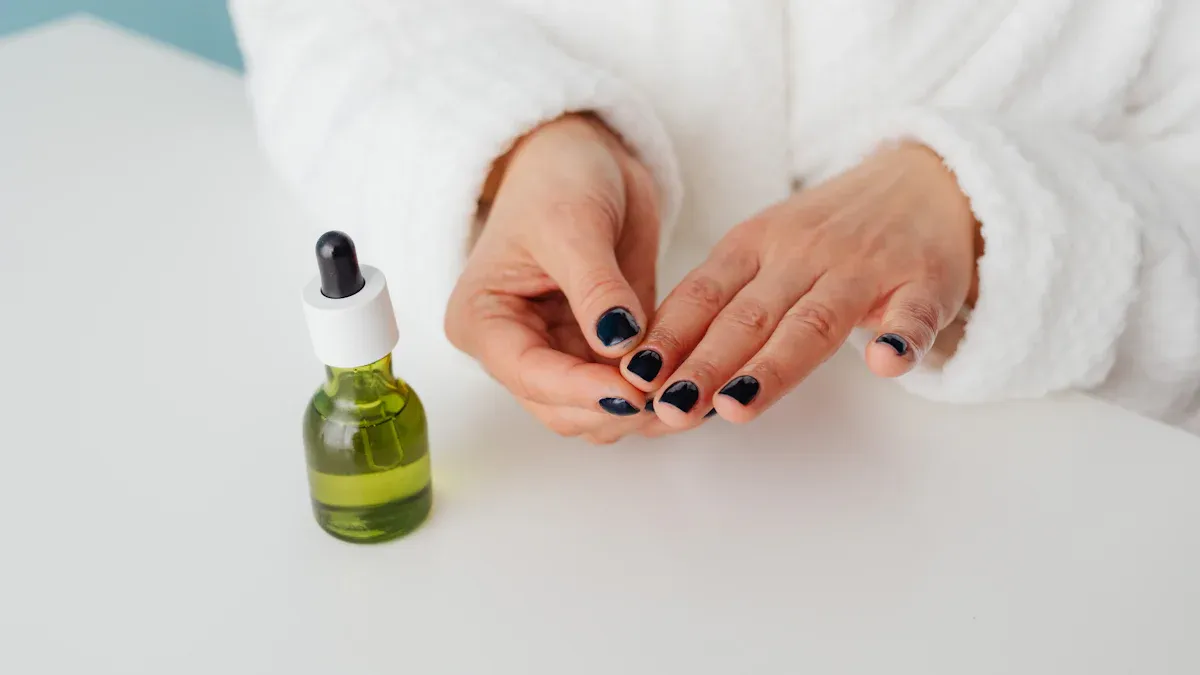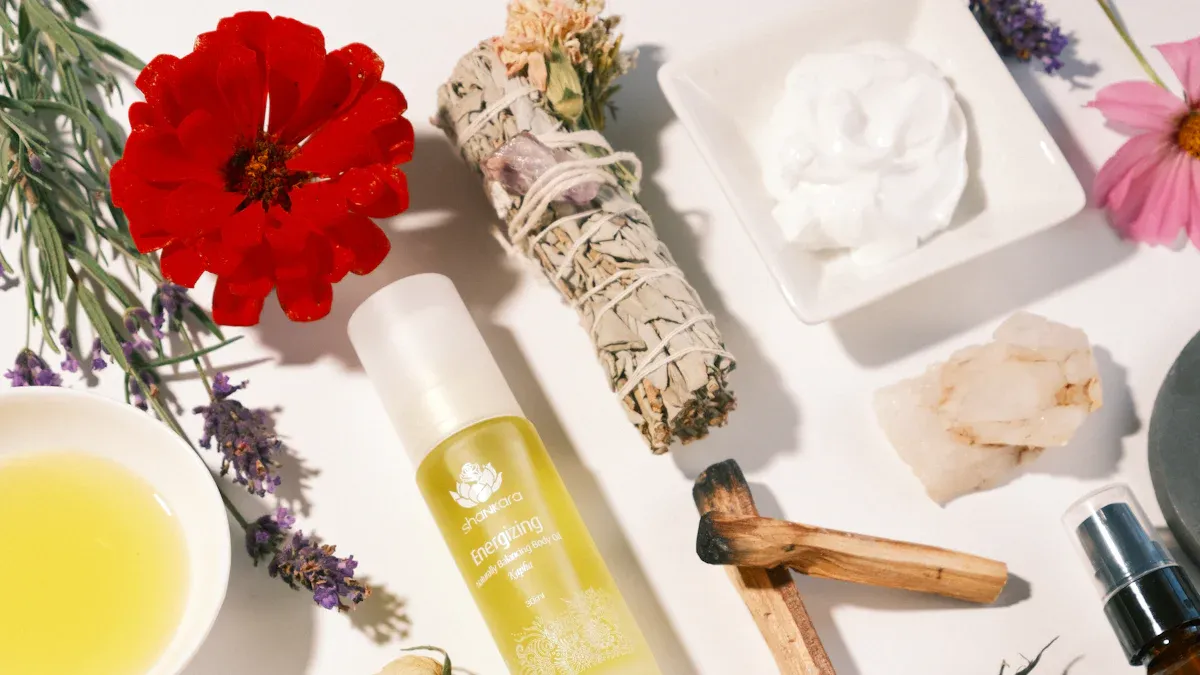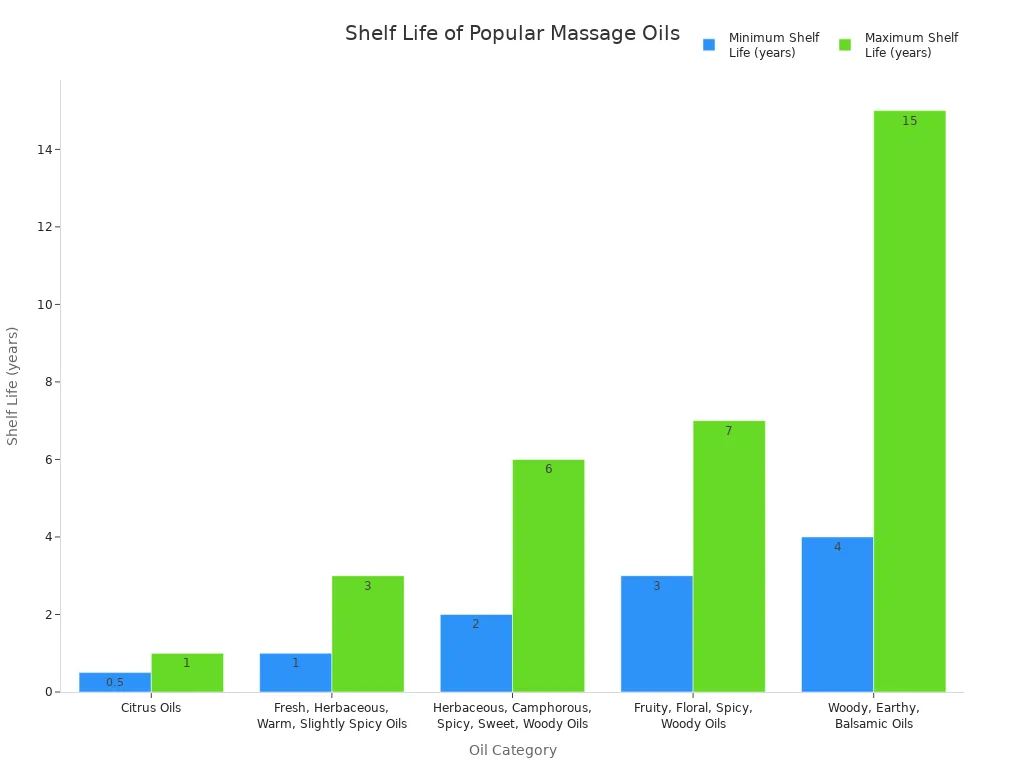
You want to find the best massage oil for your body, but it can feel confusing with so many choices. Picking the right oil matters because your skin and your goals are unique. Maybe you want deep relaxation, relief from sore muscles, or just softer skin. Studies show that when you match massage oil to your needs, you feel more relaxed and get better results. Some people even notice a bigger difference with aroma oils, as certain scents can help your mind and body unwind.
Key Takeaways
-
Pick massage oils that fit your needs like relaxing, helping pain, or keeping skin soft for better results. Use oils that match your skin type. Gentle oils are good for sensitive skin. Moisturizing oils help dry skin. Light oils work best for oily skin. Choose natural, plant-based oils for healthy skin. Do not use mineral oils because they just sit on your skin and do not help. Always test a small amount of new oil on your skin first. This helps you avoid allergic reactions. Check the ingredient labels very carefully. Keep oils in dark glass bottles. Store them away from heat and light. This helps the oils stay fresh and work well for longer.
Massage Oil Goals
When you pick a massage oil, your goal matters a lot. People often want to relax, ease pain, or keep their skin soft and hydrated. Each goal points you toward different oils and scents. Let’s break down what works best for each need.
Relaxation
If you want to relax, you are not alone. Many people choose massage oils to help them unwind and feel less stressed. Lavender essential oil stands out for relaxation. Studies show that lavender oil can lower anxiety and help you feel calm. The scent of lavender works with your brain to boost your mood and even improve sleep. You can mix a few drops of lavender oil with a carrier oil like almond or jojoba for a soothing massage. This blend helps your body and mind let go of tension.
Tip: Try a lavender-infused massage oil before bedtime if you have trouble sleeping.
Pain Relief
Do you have sore muscles or aches? Some oils work better for pain relief. Lavender oil helps with pain, too, but you can also look for eucalyptus, ginger, or peppermint oils. These oils have been tested in clinical trials and show real results for easing pain from things like sore joints, back pain, or even menstrual cramps. You can use a table to see which oils help with different types of pain:
|
Essential Oil |
Best For |
|---|---|
|
Lavender |
Muscle aches, headaches |
|
Eucalyptus |
Joint pain, stiffness |
|
Ginger |
Arthritis, sore muscles |
|
Peppermint |
Tension, headaches |
Mix these essential oils with a carrier oil before using them on your skin.
Hydration
If your skin feels dry, you want a massage oil that hydrates. Almond oil is a top pick for this. It gives your skin vitamins and keeps it soft and smooth. Coconut oil and sesame oil also work well for deep hydration. These oils soak into your skin and help it stay healthy. Some blends even add herbs for extra nourishment.
Note: Hydrating oils can make your skin look brighter and feel stronger.
Skin Type Matters

Your skin is unique, so the right massage oil can make a big difference. Picking an oil that matches your skin type helps you get the most out of every massage. Let’s look at what works best for sensitive, dry, and oily skin.
Sensitive Skin
If your skin gets red or itchy easily, you need gentle oils. Some oils are less likely to cause a reaction and are called hypoallergenic. Here’s a quick look at some of the best choices:
|
Oil Name |
Skin Benefits & Notes |
Expert/Study Support |
|---|---|---|
|
Jojoba Oil |
Calms skin, helps heal, rarely causes allergies |
Dermatologists see very few reactions |
|
High in vitamin E, protects skin barrier, gentle for eczema-prone skin |
Studies show less irritation than olive oil |
|
|
Shea Butter |
Melts on skin, soothes, very low allergy risk |
Dermatologists report almost no allergic reactions |
|
Grapeseed Oil |
Light, full of antioxidants, rarely causes problems |
Experts recommend for sensitive skin |
|
Rosehip Oil |
Fights inflammation, helps with eczema, gentle for most people |
Studies show benefits for sensitive skin |
Tip: Always do a patch test before using a new oil. Put a small amount on your inner arm and wait 24 hours to check for any reaction.
Dry Skin
Dry skin needs extra moisture. Some oils work better because they lock in water and help repair your skin barrier. Here are some top picks:
-
Marula Oil: Full of antioxidants and fatty acids. Helps your skin hold onto moisture.
-
Avocado Oil: Packed with vitamins A, D, and E. Great for rough or flaky skin.
-
Shea Butter: Soothes and softens. Works well for chapped or irritated skin.
-
Almond Oil: Deeply hydrates and helps with itchy patches.
-
Sunflower Oil: Keeps your skin barrier strong and healthy.
-
Coconut Oil: Moisturizes and protects, but use with care if you have sensitive or acne-prone skin.
You can try different oils to see which one feels best. Many people find that a blend gives the best results.
Oily Skin
Oily skin needs a light massage oil that won’t clog pores. Oils high in linoleic acid, like grapeseed, sunflower seed, and safflower oil, work well. These oils help balance your skin and keep it clear. Grapeseed oil and rosehip seed oil are also good choices because they absorb quickly and help with acne scars. Studies show that sunflower seed oil improves the skin barrier without making skin greasy. Experts say to avoid heavy oils like coconut or shea butter if you break out easily. If you want extra help, try blending a light oil with a few drops of neem oil for its antimicrobial benefits.
Note: Even if an oil is gentle, always test it first. Your skin will thank you!
Choosing the Right Massage Oil
Natural Oils
When you choose a massage oil, you want more than just slippery skin. Plant-based oils come from nuts, seeds, and fruits. They have lots of vitamins, antioxidants, and healthy fats. These oils soak into your skin and give it moisture. Your skin feels soft and healthy after using them.
Here are some reasons people like plant-based oils:
-
They help your skin stay soft and hydrated.
-
They have antioxidants that protect your skin.
-
They soak in fast and do not just sit on top.
-
They are good carrier oils for essential oils.
Mineral oils are made from petroleum. They only cover your skin and do not feed it. They last longer on the shelf and wash off easily. But they do not help your skin stay healthy. Most massage therapists pick plant-based oils because they are better for your skin.
Tip: For the best results, try almond, jojoba, coconut, grapeseed, or avocado oil. These are gentle and work for most people.
Here is a chart to help you pick the right oil:
|
Oil Name |
Best For |
Extra Benefits |
|---|---|---|
|
Sweet Almond |
Dry skin, all-purpose |
Absorbs fast, gentle, full of vitamins |
|
Jojoba |
Sensitive, oily skin |
Like skin’s oils, does not clog pores |
|
Coconut |
Dry, rough skin |
Deep moisture, soothes skin |
|
Grapeseed |
Oily, acne-prone skin |
Light, balances oil, antioxidant |
|
Avocado |
Very dry, mature skin |
Full of vitamins, calms irritation |
|
Sunflower |
Sensitive, eczema |
High in vitamin E, protects skin |
Essential Oils
Essential oils make your massage special. They come from plants and flowers and have strong smells. Many people use them for their healing effects. Lavender helps you relax and sleep better. Peppermint cools your skin and helps sore muscles. Eucalyptus can help you breathe and ease aches.
Studies show that oils like lavender, bergamot, and ylang-ylang can boost your mood and lower stress. They help your body make more serotonin, which makes you feel happier. Mix a few drops of essential oil with a carrier oil before using it.
Here is a table of popular essential oils and what they do:
|
Essential Oil |
What It Helps With |
|---|---|
|
Lavender |
Relaxation, anxiety, sleep |
|
Peppermint |
Headaches, muscle pain, energy |
|
Eucalyptus |
Congestion, sore muscles, focus |
|
Bergamot |
Stress, mood, skin health |
|
Ylang-Ylang |
Calm, happiness, skin balance |
|
Grapefruit |
Uplifting, circulation, cellulite |
Note: Always mix essential oils with a carrier oil. Test a small spot on your skin first.
What to Avoid
Not every oil is safe for everyone. Some ingredients can cause allergies or other problems. Mineral oil is one to skip if you want healthy skin. It does not give your skin any vitamins or nutrients. It just sits on top and can block pores for some people.
Some essential oils and scents can also cause problems. Watch out for these common allergens on labels:
-
Limonene
-
Linalool
-
Hydroxyisohexyl 3-cyclohexene carboxaldehyde (HICC)
-
Oak moss
If you have asthma or breathing problems, avoid oils with strong smells or menthol. These can make it hard to breathe. Pregnant people should not use oils like wormwood, rue, camphor, and sage. If you have estrogen-dependent tumors, do not use lavender or tea tree oils.
Alert: Always check the ingredient list. If you see a name you do not know, look it up or ask your massage therapist. When you are not sure, pick simple, natural oils.
Texture and Scent

Absorption
When you pick an oil for massage, you want to think about how it feels on your skin. Some oils feel light and soak in fast. Others feel thick and stay on the surface longer. The thickness and absorption rate change how the massage feels. If you like a quick, gentle massage, you might want a lighter oil. For a deep, slow massage, a heavier oil works better.
Here’s a table to help you see how different oils work:
|
Oil Type |
Absorption Rate |
Best For |
|---|---|---|
|
Sweet Almond Oil |
Quick, non-greasy |
Relaxation, facial massages |
|
Coconut Oil |
Light, non-greasy |
Intense, restorative massages |
|
Jojoba Oil |
Like skin’s own oils |
Therapeutic, sensitive skin massages |
|
Olive Oil |
Slow, heavier |
Deep tissue, longer massages |
|
Grapeseed Oil |
Quick, light |
Hairy or dry skin, minimal residue |
|
Apricot Kernel Oil |
Very quick, non-greasy |
Facial massages |
|
Avocado Oil |
Slow, rich |
Extra moisture, deep massages |
Lighter oils like grapeseed and sunflower soak in fast. They leave little residue, so your skin feels clean after. Heavier oils like olive and avocado stay longer. They give more glide for deep work and leave your skin soft.
Tip: If you want less mess, pick a quick-absorbing oil. For extra moisture, try a heavier one.
Fragrance
Scent can change your whole massage experience. Some people love relaxing smells like lavender or eucalyptus. These scents help you unwind and feel calm. Others want no scent at all. Maybe you have allergies or just want a simple, clean feeling.
Many people now look for fragrance-free or allergen-free products. If you have sensitive skin or eczema, you might want to skip strong scents. Spas often offer both scented and unscented oils. This way, you can choose what feels best for you.
-
Scented oils give a full sensory experience and help with relaxation.
-
Fragrance-free oils are great for sensitive skin or if you want a neutral option.
-
Some people need unscented oils for medical or allergy reasons.
Note: Always ask about scent options before your massage. You deserve a comfortable and enjoyable experience.
Quality and Safety
Purity
When you pick an oil for your skin, purity matters most. You want to know what you are putting on your body. Many bottles use words like "therapeutic grade" or "massage grade," but these are just marketing tricks. No official group checks these labels. Instead, look for oils that say "certified organic." This label means the oil is pure and free from harmful chemicals.
You can also check for quality standards. Some companies follow ISO rules to make sure their oils are safe and pure. Here’s a quick look at some ISO standards you might see:
|
ISO Standard |
What It Means |
|---|---|
|
Company meets strict quality rules |
|
|
ISO 22000:2005 |
Safe food-grade oils |
|
ISO/TS 210:2014 |
Safe containers and storage for oils |
|
ISO/TS 211:2014 |
Clear labels on bottles |
|
ISO 212:2007 |
Good ways to test oil samples |
Tip: Always read the label. If you see "certified organic," you can trust the oil is pure.
Sourcing
You want to feel good about where your oil comes from. Ethical and sustainable sourcing helps protect the planet and supports fair work. Good brands share their values and show proof of their efforts. Look for companies that talk about their environmental actions and have real certifications.
Here are some brands and what they do for the planet:
|
Brand |
What They Do for Ethics & Sustainability |
Certifications |
|---|---|---|
|
Uses organic plants, recycled bottles, solar energy |
Soil Association, CarbonNeutral® |
|
|
Vitruvi |
Vegan, cruelty-free, supports clean farming |
Leaping Bunny |
|
Mountain Rose Herbs |
Wild-harvested plants, zero waste, fair trade |
TRUE Zero Waste, Fair Trade |
|
Bursera |
Plants trees, uses recycled packaging |
Carbon-neutral, 1% for the Planet |
|
doTERRA |
Fair supplier practices, eco-friendly packaging |
CPTG Certified Pure Tested Grade® |
🌱 Choose brands that care about people and the earth. Check for certifications like Fair Trade or CarbonNeutral®.
Storage
How you store your oils keeps them fresh and safe. Oils last longer if you keep them away from heat, light, and air. Always use dark glass bottles, like amber or blue, to block sunlight. Store your oils in a cool, dark place, not in the bathroom or near a window. Close the cap tight after each use.
Here’s a table to help you remember how long oils last and how to store them:
|
Oil Type |
Shelf Life |
Storage Tips |
|---|---|---|
|
Citrus (lemon, orange) |
Dark glass, cool, dark place, tight cap |
|
|
Herbaceous (eucalyptus, rosemary) |
1–3 years |
Avoid heat, sunlight, humidity |
|
Woody (sandalwood, vetiver) |
4–15 years |
Airtight, cool, dark, can improve with age |

Note: Always label your bottles with the date you bought them. Use older oils first so nothing goes to waste.
Patch testing is smart, too. Some people react to oils, even pure ones. Try a small amount on your arm and wait a day. If your skin stays calm, you are good to go.
Choosing the right massage oil is all about you. Start by thinking about your goals, your skin type, and what feels good. Try these expert steps:
-
Decide what you want from your massage—relaxation, pain relief, or hydration.
-
Check your skin type and look for oils that match.
-
Pick high-quality oils and store them well.
Don’t be afraid to try new oils. You might find a favorite that makes every massage feel special.
FAQ
Can I use cooking oils for massage?
You can use some cooking oils, like coconut or olive oil, for massage. Make sure the oil is pure and cold-pressed. Avoid oils with added flavors or preservatives. Always do a patch test first.
How do I know if I’m allergic to a massage oil?
Do a patch test. Put a small drop of oil on your inner arm. Wait 24 hours. If you see redness, itching, or swelling, do not use that oil.
What’s the best oil for a relaxing massage at home?
Lavender-infused almond oil works great for relaxation. The scent helps you unwind. You can also try jojoba oil with a few drops of chamomile essential oil for a calming effect.
Can I mix different oils together?
Yes, you can blend oils to get the benefits you want. Try mixing a carrier oil, like grapeseed, with a few drops of your favorite essential oil. Always test your blend on a small patch of skin first.
How should I store my massage oils?
Keep your oils in dark glass bottles. Store them in a cool, dry place away from sunlight. Make sure the caps are tight. This helps your oils stay fresh longer. 🧴










